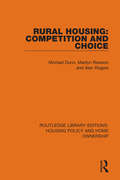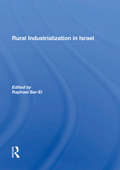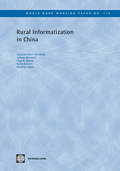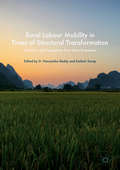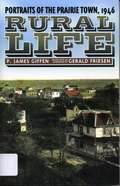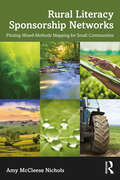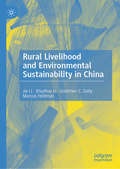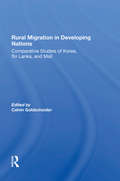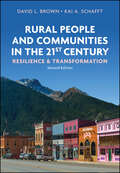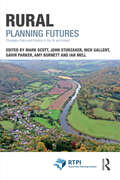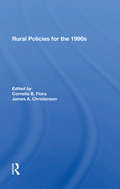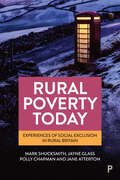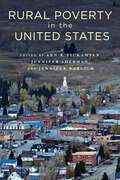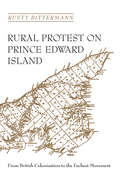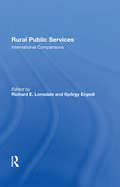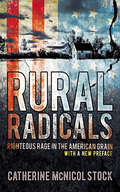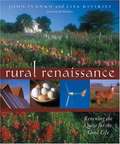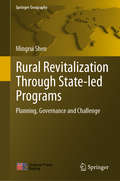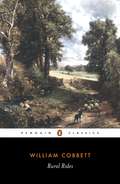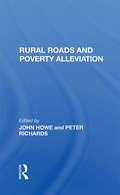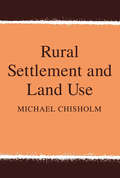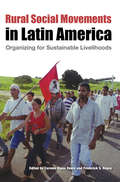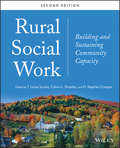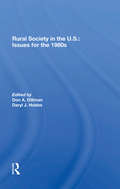- Table View
- List View
Rural Housing: Competition and Choice
by Michael Dunn Alan Rogers Marilyn RawsonOriginally published in 1981, this book explores the plight of the locally born or locally employed faced with spiralling house prices and strong and unequal competition from the wealthier commuter, second-home owner or retirement migrant. It was the first book to examine the policy and planning issues in relation to these problems from the starting point of basic research and analysis.
Rural Industrialization In Israel
by Raphael Bar-el Ariela Nesher Mosche Schwartz Rachel FinkelRural development in Israel consists of a unique variety of industrialization experiences that may be instructive for many countries at various stages of development. The social, ideological, political, economic, and organizational precepts that Israel's rural settlements are based on lend themselves to many different approaches. This book deals with industrialization patterns in the kibbutz, the moshav, the non-agricultural village, and the Arab village. Prevailing conditions (size and labor force, availability of skills, infrastructure) and objectives (creation of employment, improvement of living standards) vary depending on the specific type of settlement As a result, optimal policy for rural industrialization is different from village to village. The authors give the general background of and define the specific development objectives for each type of village. They review relevant conditions at the local and regional levels; analyze the individual experiences of industrial development; evaluate economic achievement and attainment of development goals; and determine influential factors. The final aim is to reassess Israeli policies and strategies and offer lessons to other countries undertaking rural industrialization.
Rural Informatization in China
by Kaoru Kimura Nagy Hanna Asheeta Bhavnani Christina Zhen-Wei Qiang Randeep SudanChina's recent economic growth has expanded industrialization and urbanization, upgraded consumption, increased social mobility, and initiated a shift from an agricultural-based economy to one based on services and industry. However, more than half of China's population still lives in rural areas, where the average per capital income is less than a third of the urban average. The government of China has increased its commitment to rural development and poverty-reduction programs, with attention to narrowing the rural-urban divide. Informatization-defined as the transformation of an economy and society driven by information and communications technology (ICT)-is increasingly being explored as a way of helping poor people. Rural Informatization in China presents an overview and in-depth analysis of rural ICT initiatives in China. This study reviews the present-day status of China's rural informatization infrastructure, examines and summarizes by organizational model the key initiatives in the past decade, and provides policy recommendations to address current challenges. Case studies of different financing models of rural ICT initiatives from China and other countries are included.
Rural Labour Mobility in Times of Structural Transformation
by D. Narasimha Reddy Kailash SarapThis book examines essential issues and perspectives on rural labour, helping readers understand the changes that are currently taking place in the labour markets, especially with regard to migrants from rural to urban areas, their socio-economic conditions, factors contributing to such mobility and associated problems. Further, it addresses the question of why the socio-economic conditions of rural labour have not experienced measurable improvements. Presenting a collection of painstakingly researched essays that focus on both India and China, the book addresses these challenges with an explicit focus on safeguarding the interests of rural labour under the neoliberal dispensation. The research is based on primary survey data and analytical issues from selected Asian economies, especially from India. On the basis of the findings discussed, it subsequently suggests ways forward so as to improve the wellbeing of migrant households and put an end to distress migration. Lastly, the book convincingly argues that improving labour market outcomes, and more specifically, generating employment and providing alternative livelihood avenues, represents the most pressing challenge in rural areas.
Rural Life: Portraits of the Prairie Town, 1946
by James P. GiffenIn the 1940s, the Manitoba Royal Commission on Adult Education investigated directions for the modernization of the province in the post-war era of change. It was charged particularly with looking at rural Manitoba’s cultural, educational, and leadership opportunities in the wake of new technologies, dwindling populations, and altered political and social affiliations. The commission engaged Jim Giffen, then a young sociologist from the University of Toronto, to undertake a detailed field study of three rural Manitoba towns in this context.Giffen’s extensive study examined the towns of Carman, Elgin, and Rossburn, all significantly different in terms of their ethnic makeup and level of political and organizational sophistication. He remained in the province for a year and a half, at the end of which his report, an analysis of “education for leadership,” was considered “too revealing” for public release. It remained in the Ontario Legislative Library until it was retrieved, 50 years later, by well-known historian Gerald Friesen, who has written an extensive postscript to the report.As a snapshot of rural agricultural life in prairie Canada at a time of great change, the study is invaluable. Despite the differences in the three towns, they retain some common characteristics that define a particular socio-cultural view of the larger world. Giffen looks at characteristics such as leadership in the community, ethnic differences, hierarchy of roles, participation in organizations, and aims and activities of young people. Friesen’s postscript provides a wider context to this study, and an assessment of what these differences and commonalities meant to the province.
Rural Literacy Sponsorship Networks: Piloting Mixed-Methods Mapping for Small Communities
by Amy McCleese NicholsThis text provides an in-depth exploration of rural community literacy, examining the ways in which community-building, social networks, time, race, and politics interplay.Mapping the dense literacy sponsorship network of a small rural town in the southeastern United States, Nichols offers a window into the challenges and successes of collective literacy sponsorship. Through an original mapping-focused approach, the book explores multiple social and environmental layers that construct literacy sponsorship writ large.This approach provides a novel methodological entry to rural literacies and will be key reading for rural community literacy advocates, literacy scholars, graduate students, and researchers.
Rural Livelihood and Environmental Sustainability in China (China Connections Ser.)
by Gretchen C. Daily Jie Li Shuzhuo Li Marcus FeldmanThe book considers the challenge of poverty and deterioration of the ecological environment in China, particularly in rural areas. Examining key factors such as the overuse of natural resources and the loss of biodiversity in the face of an expanding population and rapidly developing economy. It focuses on examining the frameworks of rural households in poor mountainous areas in rural China, considering their livelihood choices and decision-making processes. It analyses the relationship between these households’ livelihoods and their environment, notably farmers’ attitudes and perceptions towards ecological conservation policies, and their use of forest resources. Cutting across the fields of population studies, sociology, economy and environment, this is an important read for scholars and students interested in how China is dealing with the challenges of natural resources exploitation, sustainable development and social welfare.
Rural Lives and Landscapes in Late Byzantium
by Gerstel, Sharon E. J.This is the first book to examine the late Byzantine peasantry through written, archaeological, ethnographic, and painted sources. Investigations of the infrastructure and setting of the medieval village guide the reader into the consideration of specific populations. The village becomes a micro-society, with its own social and economic hierarchies. In addition to studying agricultural workers, mothers, and priests, lesser-known individuals, such as the miller and witch, are revealed through written and painted sources. Placed at the center of a new scholarly landscape, the study of the medieval villager engages a broad spectrum of theorists, including economic historians creating predictive models for agrarian economies, ethnoarchaeologists addressing historical continuities and disjunctions, and scholars examining power and female agency.
Rural Migration In Developing Nations: Comparative Studies Of Korea, Sri Lanka, And Mali
by Calvin GoldscheiderWhat is the relationship between migration and rural social structure? How does the selective movement out of rural areas affect the economic and social conditions of migrants, their families, and their places of origin? Addressing these and other questions, the contributors to this book consider rural migration patterns in the context of social change and economic development in three less developed nations: Korea, Sri Lanka, and Mali. Through comparative analysis the authors reveal both the diversity and the cross-national similarities of rural migration, offering theoretical bases for its interpretation and pointing to policy implications for developing areas.
Rural People and Communities in the 21st Century: Resilience And Transformation
by David L. Brown Kai A. SchafftRural people and communities continue to play important social, economic and environmental roles at a time in which societies are rapidly urbanizing, and the identities of local places are increasingly subsumed by flows of people, information and economic activity across global spaces. <P><P>However, while the organization of rural life has been fundamentally transformed by institutional and social changes that have occurred since the mid-twentieth century, rural people and communities have proved resilient in the face of these transformations. <P><P>This book examines the causes and consequences of major social and economic changes affecting rural communities and populations during the first decades of the twenty-first century, and explores policies developed to ameliorate problems or enhance opportunities. Primarily focused on the U.S. context, while also providing international comparative discussion, the book is organized into five sections each of which explores both socio-demographic and political economic aspects of rural transformation. It features an accessible and up-to-date blend of theory and empirical analysis, with each chapter's discussion grounded in real-life situations through the use of empirical case-study materials. <P><P> Rural People and Communities in the 21st Century is intended for advanced undergraduate and graduate courses in rural sociology, community sociology, rural and/or population geography, community development, and population studies.
Rural Planning Futures: Principles, Policy and Practice in the UK and Ireland (RTPI Library Series)
by Mark ScottRural Planning Futures charts the critical societal challenges that are reshaping rural places across the UK and Ireland. The book evaluates current planning processes and explores the prospects for an enhanced, cross-sectoral and holistic future practice that mediates rural change towards more resilient and sustainable outcomes. Rural places and planning have, for too long, been viewed as marginal to both the theory and practice of planning. However, rural places are central to addressing critical global challenges – from climate action, through nature recovery, energy transitions, and food security, to water quality – while also facing more localised conflicts around housing, the siting of infrastructure, and the challenge of sustaining local services. The policy response to these complex challenges has too often been fragmented, siloed, and fixated on the short-term. By illustrating how key 'rural capitals' are linked and integrated, this book argues for a reset of the rural planning narrative and for the urgent disruption of established ways of working. Using innovative case studies, the chapters detail how planning for rural places must be guided by the pursuit of social value rather than protecting private interests. This book is essential reading for undergraduate and graduate students in planning, geography, rural studies, landscape studies, and regional studies.
Rural Policies For The 1990s
by James A Christenson Cornelia FloraCrisis in rural America is by now an all too familiar complaint, yet the problems presented by changing demographics, economic decline, and increasing poverty persist. They have not vanished with a new administration. However, with a new farm bill in the offing, now is the time for a fresh initiative to assess the difficulties facing nonurban America and to offer positive solutions. Rural Policies for the 1990s, written by some of the foremost experts on rural America, focuses on policy-relevant research. Within a carefully crafted framework, the contributors present stimulating discussions on resolving problems and improving the situation in rural areas. Looking at the crucial issues of employment, demographics, environment, technology, and the global impacts of national and international policies, they offer a broad analysis that is neither regionally based nor biased. The result is not an advocacy book, but one that effectively enhances our understanding of the problems facing rural America and presents concrete proposals for revitalizing it.
Rural Poverty Today: Experiences of Social Exclusion in Rural Britain
by Jayne Glass Mark Shucksmith Polly Chapman Jane AttertonPoverty is perceived as an urban problem, yet many in rural Britain also experience hardship. This book explores how and why people in rural areas experience and negotiate poverty and social exclusion. It examines the role of societal processes, individual circumstances, sources of support (markets; state; voluntary organisations; family and friends) and the role of place. It concludes that the UK’s welfare system is poorly adapted to rural areas, with the COVID-19 pandemic, Brexit and cutbacks exacerbating pressures. Voluntary organisations increasingly fill gaps in support left by the state. Invaluable to those in policy and practice, the book recommends a combination of person-based and place-based approaches to tackle rural poverty.
Rural Poverty in the United States
by Ann Tickamyer Jennifer Sherman Jennifer WarlickAmerica's rural areas have always held a disproportionate share of the nation's poorest populations. Rural Poverty in the United States examines why. What is it about the geography, demography, and history of rural communities that keeps them poor? In a comprehensive analysis that extends from the Civil War to the present, Rural Poverty in the United States looks at access to human and social capital; food security; healthcare and the environment; homelessness; gender roles and relations; racial inequalities; and immigration trends to isolate the underlying causes of persistent rural poverty.Contributors to this volume incorporate approaches from multiple disciplines, including sociology, economics, demography, race and gender studies, public health, education, criminal justice, social welfare, and other social science fields. They take a hard look at current and past programs to alleviate rural poverty and use their failures to suggest alternatives that could improve the well-being of rural Americans for years to come. These essays work hard to define rural poverty's specific metrics and markers, a critical step for building better policy and practice. Considering gender, race, and immigration, the book appreciates the overlooked structural and institutional dimensions of ongoing rural poverty and its larger social consequences.
Rural Protest on Prince Edward Island: From British Colonization to the Escheat Movement
by Rusty BittermannWho has the more legitimate claim to land, settlers who occupy and improve it with their labour, or landlords who claim ownership on the basis of imperial grants? This question of property rights, and their construction, was at the heart of rural protest on Prince Edward Island for a century. Tenants resisted landlord claims by squatting and refusing to pay rent. They fought for their vision of a just rural order through petitions, meetings, rallies, electoral campaigns, and direct action. Landlords responded with their own collective action to protect their interests. In Rural Protest on Prince Edward Island Rusty Bittermann examines this conflict and the dynamic of rural protest on the Island from its establishment as a British colony in the 1760s to the early 1840s.The focus of Bittermann's study is the remarkable mass movement known as the Escheat movement, which emerged in the 1830s in the context of growing popular challenges elsewhere in the Atlantic World. The Escheat movement aimed at resolving the land question in favour of tenants by having the state resume (escheat) the large grants of land that created landlordism on the Island. Although it ultimately gained control of the assembly in the late 1830s, the Escheat movement did not produce the land policies that tenants and their allies advocated. The movement did, however, synthesize years of rural protest and produce a persistent legacy of language and ideas concerning land, justice, and the rights of small producers that helped to make landlordism on the Island unsustainable in the long term. Rural Protest on Prince Edward Island is a comprehensive and fascinating examination of an important, but often overlooked, period in the history of Canada's smallest province.
Rural Public Services: International Comparisons
by Richard E Lonsdale Gyorgy EnyediInterest in the special problems of rural areas and concern with rural development in general have increased substantially throughout much of the world in the years since about 1960. Attesting to this has been the dramatic increase in attention to rural problems in the scholarly and popular literature and by government agencies. At first the dominant focus was on development projects and the creation of new jobs. It was not long, however, until other related issues came to the fore, in particular the availability and quality of public services essential to achieve economic growth and improvement and having a direct bearing on the well-being of rural peoples. Most nations of the world have developed plans and launched pro-jects to improve rural public services and narrow urban-rural dif-ferentials in their provision. As one would expect, there have been great differences between nations in the severity of problems, foci of attention, program strategies and their general effectiveness, and degree of commitment and effort. Given this diversity, it seems ap-propriate to examine and compare rural service problems and efforts to ameliorate them in a sample of contrasting societies. Implicit is the conviction that (1) all nations can learn at least something from the experiences of others, and (2) by taking an international, com-parative view of the subject, certain generalizations can be established.
Rural Radicals: Righteous Rage in the American Grain
by Catherine McNicol StockThrough its history, populism has meant hope and progress, as well as hate and a desire to turn back the clock on American history. In her new preface, Catherine McNicol Stock provides an update and overview of the conservative face of rural America. She paints a comprehensive portrait of a long line of rural activists whose crusades against big government, bug business, and big banks sometimes spoke in a language of progressive populism and sometimes in a language of hate and bigotry. Rural Radicals breaks down the populism expressed by activists, confronts our conventional notions of right and left, and allows us to understand political factionalism differently.
Rural Renaissance: Renewing The Quest For The Good Life
by Bill Mckibben John D. Ivanko Lisa KiviristIn the '60s it was called the "back to the land" movement, and in Helen and Scott Nearings' day, it was "living the good life. " Whatever the term, North Americans have always yearned for a simpler way. But how do you accomplish that today? Blending inspiration with practical how-to's, Rural Renaissance captures the American dream of country living for contemporary times. Journey with the authors and experience their lessons, laughter and love for the land as they trade the urban concrete maze for a five-acre organic farm and bed and breakfast in southwestern Wisconsin. Rural living today is a lot more than farming. It's about a creative, nature-based and more self-sufficient lifestyle that combines a love of squash, solar energy, skinny-dipping and serendipity . . . The many topics explored in Rural Renaissance include: "right livelihood" and the good life organic gardening and permaculture renewable energy and energy conservation wholesome organic food, safe water and a natural home simplicity, frugality and freedom green design and recycled materials community, friends and raising a family independence and interdependence wildlife conservation and land stewardship. An authentic tale of a couple whose pioneering spirit and connection to the land reaches out to both the local and global community to make their dream come true, Rural Renaissance will appeal to a wide range of Cultural Creatives, free agents, conservation entrepreneurs and both arm-chair and real-life homesteaders regardless of where they live. Lisa Kivirist and John Ivanko are innkeepers, organic growers, copartners in a marketing consulting company, and have previously published books. John is also a photographer. Former advertising agency fast-trackers, they are nationally recognized for their contemporary approach to homesteading, conservation and more sustainable living. They share their farm with their son, two llamas, and a flock of free-range chickens. Rural Renaissance also offers a foreword by Bill McKibben.
Rural Revitalization Through State-led Programs: Planning, Governance and Challenge (Springer Geography)
by Mingrui ShenThis book seeks to unravel the changes in rural governance sparked by state-led programs, evaluate the programs’ implementation, and refine the interpretation of governance theory with new empirical material from rural China. When it comes to rural issues in contemporary China, there is no shortage of national strategies: from “Coordinating Urban–Rural Development” in 2003 to “Rural Revitalization” in 2017, the rejuvenation of the countryside has attracted unprecedented policy interest. At the same time, rural governance has been subject to significant political, social and economic changes. However, comparatively little research has been conducted on the phenomenal reconnection between the state and rural society, and our previous understanding of rural governance is no longer adequate.As a result of the programs, a new model of governance is now emerging in rural China. The programs have accelerated the formation of state-private-farmer partnerships, while also promoting the participation of grassroots society in rural reconstruction. In the initial stage, the state’s role is important to securing non-governmental sectors’ engagement. However, this does not mean that the model guarantees sustainable governance: in terms of land tenure reform, infrastructure investment, and subsidies, the programs merely empower farmers and other stakeholders to engage in rural reconstruction. The success of these reconstruction efforts ultimately depends on a suitable pricing mechanism for public goods provision, as well as the self-organization of grassroots society.
Rural Rides: In The Counties Of Surrey, Kent, Sussex, Hants, Berks, Oxford, Bucks, Wilts, Somerset, Gloucester, Hereford, Salop, Worcester,j Stafford
by William CobbettTravelling on horseback through southern England in the early 19th century, William Cobbett provides evocative and accurate descriptions of the countryside, colourful accounts of his encounters with labourers, and indignant outbursts at the encroaching cities and the sufferings of the exploited poor. Ian Dyck's new edition places these lively accounts of rural life in the context of Cobbett's political and social beliefs and reveals the volume as his platform for rural radical reform.
Rural Roads And Poverty Alleviation (Rural Building Course Ser. #2)
by John Howe Peter Richards J D HoweThis book analyses the use of rural road networks and the causes and effects of road programmes in the areas of personal travel, education, health and poverty alleviation. It discusses the criteria which are being used for rural road selection and their impact in Egypt, India, Botswana and Thailand.
Rural Settlement and Land Use: An Essay In Location
by Michael ChisholmTo a remarkable extent, students of location problems have fastened attention upon industrial and urban matters rather than upon agricultural and rural affairs. The preponderance of the former studies undoubtedly reflects the relative importance of the manufacturing and commercial sectors of the technically more advanced countries where most students of location matters have in the past resided. Perhaps it has also seemed that the locational problems posed by city life and factory employment are more amenable than those of the countryside to rigorous analysis.
Rural Social Movements in Latin America: Organizing for Sustainable Livelihoods
by Carmen Diana Deere Frederick S. Royce"A remarkable collection. The chapters provide extremely useful information on a range of social movements generally not well covered in academic work--and the coverage is provided by people who are either activists within the movements themselves or long-time supporters."--Wendy Wolford, University of North Carolina "An original, unique, and excellent collection. The book has great theoretical value and political relevance."--Saturnino M. Borras Jr., Saint Mary's University (Halifax) All across Latin America, rural peoples are organizing in support of broadly distinct but interrelated issues. Food sovereignty, agrarian reform, indigenous and women’s rights, sustainable development, fair trade, and immigration issues are the focus of a large number of social movements found in countries such as Bolivia, Colombia, Mexico, Nicaragua, Brazil, and Peru. The contributors to Rural Social Movements in Latin America include academic researchers as well as social movement leaders who are seeking to effect change in their countries and communities. As a group they are at the forefront of some of the most critical environmental, social, and political issues of the day. This volume highlights the central role these movements play in opposition to the neoliberal model of development and offers fresh insights on emerging alternatives at the local, national, and hemispheric level. It also illustrates and analyzes the similarities--notably the struggle for sustainable livelihoods--as well as the difference among these various peasant, indigenous, and rural women's movements.
Rural Social Work
by T. Laine Scales H. Stephen Cooper Calvin L. StreeterA thoughtful text integrating strengths, assets, and capacity-building themes with contemporary issues in rural social work practiceNow in its second edition, Rural Social Work is a collection of contributed readings from social work scholars, students, and practitioners presenting a framework for resource building based on the strengths, assets, and capacities of people, a tool essential for working with rural communities.This guide considers methods for social workers to participate in the work of sustaining rural communities. Each chapter features a reading integrating the themes of capacity-building and rural social work; discussion questions that facilitate critical thinking around the chapter; and suggested activities and assignments.Rural Social Work, Second Edition explores:Important practice issues in rural communities, including the challenges of working with stigmatized populations such as gay, lesbian, bisexual, and transgendered people, the homeless, and people living with HIV/AIDSPractice models that hold special promise for rural social workers, including evidence-based practice and community partnership modelsNewer research tools such as asset mapping, social network analysis, concept mapping, and Geographic Information Systems (GIS)Exploring how social workers can integrate the tremendous resources that exist in rural communities into their practice, Rural Social Work, Second Edition provides a solid introduction to the complex, challenging, and rewarding work of building and sustaining rural communities.
Rural Society In The U.s.: Issues For The 1980s
by Don A Dillman Daryl J HobbsMust rural Americans pay the price of urban progress and modern lifestyles? How will the increased pressures of the 1980s affect those who live and work in rural communities? In addressing these overriding questions the authors of this book take a serious look at such issues as who will operate our farms and how those farms will meet rising demands for food, how higher energy costs will change life in rural areas, the current and future needs of rural families and their communities, who in fact lives in these communities, and what can be done about escalating rural crime and recent social changes that have disrupted the traditional patterns of rural society. Because the United States is an interdependent system of rural and urban, of providers and consumers, these issues are vitally important to all-scholars, policy makers, and citizens alike. The contributors bring us up to date on the contemporary rural scene and offer suggestions for research essential to intelligent decision making about the challenges and problems the 1980s hold in store for rural America.
